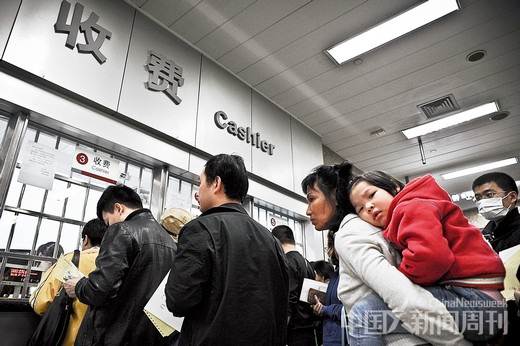
(Ecns.cn) – China's public hospitals have for many years faced a host of problems which have undermined comprehensive reform. And although the government has rolled out a raft of measures to address the situation, operational deficits continue to plague the current medical system.
According to Zhang Ping, a public hospital director, most government-backed public hospitals suffer from losses every year and many medical workers are sorely underpaid.
This has inevitably given rise to other issues, such as doctors seeing too many patients and prescribing more medications than necessary, plunging the medical sector into a vicious cycle, notes China Newsweek.
Sick hospitals
Private investment in the medical sector is becoming very popular in China, and investing in public hospitals could create a great deal of profit, says Zhu Zhongyuan, managing director of Greenwoods Capital, which manages a fund worth 12 billion yuan (US$1.9 billion).
Zhang Ping, who works at a 3A-level hospital in Beijing, does not share Zhu's optimism. He claims his hospital must receive a government subsidy of more than 50 million yuan (US$7.9 million) just to achieve a balanced budget.
According to Zhang, it is commonplace for public hospitals to have low profits, and even those in the U.S. only have an average net profit margin between three and six percent every year.
Some departments such as ophthalmology may be able to deliver impressive money-earning performance, but there are usually more unprofitable departments in general hospitals that hinder overall earnings, adds Zhang.
In 2010, the revenue at the hospital under Zhang's administration was approximately 1.7 billion yuan (US$269 million), while the loss rate was about three percent, part of which was later subsidized by the government, according to China Newsweek.
The public may be surprised that most public hospitals are confronted with same situation, despite a permanent shortfall of hospital beds and a heavy work burden for doctors, but this is the state of the medical sector, says Zhang.
Doctor-patient tension
The price of medical services is very low in China and has not changed much in the last two decades. This is primarily a result of price controls imposed by the government, says Zhang, but the system has not caught up with the times.
For example, an appendectomy costs 234 yuan (US$37) at a 3A-level hospital, but requires a medical team consisting of eight staff members who must work one to two hours. Regardless of other costs, a surgeon or nurse earns less than 30 yuan (US$4.8) to carry out such a procedure.
In departments such as gastroenterology and pediatrics, which provide many traditional medical services, similar surgeries are often carried out at a deficit.
Moreover, healthcare staff members are usually underpaid in public hospitals. A young doctor at a 3A-level hospital in Beijing earns little more than 2,000 yuan (US$317) a month, and the stipend for a night shift is only 20 yuan (US$3).
Under such conditions, many doctors must supplement their incomes through prescription drug sales, from which they get kickbacks from pharmaceutical companies. This has become a hidden rule in the medical sector, and an institutional problem that cannot simply be solved by punishing medical staff.
Such practices have stoked tensions between doctors and patients, and have even resulted in outbreaks of violence in hospitals, says Zhang.
Last month, Wang Hao, a young internist at the First Affiliated Hospital of Harbin Medical University in northwest China, was brutally murdered by a disgruntled patient named Li Mengnan. The tragedy occurred when Li sought medical help but was not given immediate treatment.
The incident reflects the simmering tensions between doctors and patients in China. Last September, a patient stabbed and seriously injured a female surgeon at Beijing Tongren Hospital following a medical dispute, in which the patient alleged that the surgeon had committed malpractice during an operation.
Pushing forward reform
As China recognizes a pressing need for medical reform, the government is determined to overcome any challenges involved, said Vice Premier Li Keqiang after the State Council released its 2012 reform plan last week.
According to that plan, a complex approach will be introduced: public hospitals will be financed by increasing government subsidies and adjusting the prices of medical services. Yet even if prices are raised, the government will see to it that this will not lead to rising medical bills for patients.
In his remarks, Li also pledged to separate medical services from drug management and increase the incomes of doctors.
Chen Zhu, minister of Health, argued that overemphasis on a market orientation does not suit the nature of China's socialist system and medical sector, but that introducing private clinics into the public medical insurance system is a good way to encourage competition.
On April 23, the Ministry of Health reported that its 2012 budget will amount to 80 billion yuan (US$12.7 billion), in which 10.9 billion yuan (US$1.7) will go to medical services in an effort to improve the capacity of major clinical departments at public hospitals.

Copyright ©1999-2011 Chinanews.com. All rights reserved.
Reproduction in whole or in part without permission is prohibited.